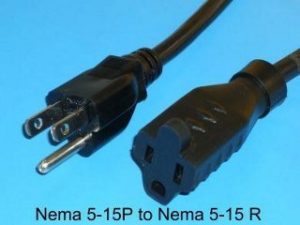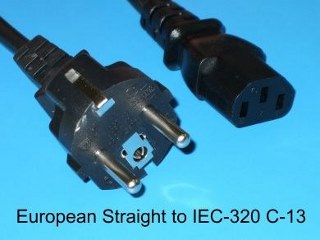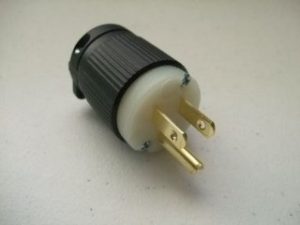
A Complete Guide On Different Types of Power Cords
Everyone uses electricity. However, the cords, sockets, and plugs differ as you travel from country to country. Usually, this can cause some inconvenience to the layperson and pose a risk to those who work with electricity.
Therefore, learning and knowing the different types of power cords used to conduct electricity can save you time, frustration, and money.
As you’ll find out in the subsequent sections, different power cords exist for a reason. We’ll explore the varieties of power cord, their uses, and their history in this post.
But before going into the deep end, what exactly is a power cord?
Let’s Find out.
What Are Power Cords?
Power cords are the electrical hardware used primarily to transfer alternating (AC) and direct current (DC). Most manufacturers in the electrical industry use copper to manufacture power cords. These copper wires are insulated with a non-conductive material, typically a plastic coating, to protect them.
According to The National Electrical Manufacturers Association (NEMA), electrical hardware such as plugs, cords, and sockets must meet specific standards and requirements. This organization sets the required receptacle configuration, cord voltage capacity, and other specifics governing the properties and operation of electrical supplies.
The types of electrical plugs in use worldwide are 15, ranging from Type A to Type O. However, the types used in the US are Type A and Type B.
But before looking at the various classifications, let’s take a quick look at the background of the power cord.
Brief History of Power Cords
The design of modern power distribution is credited to Thomas Edison in 1882. Edison coiled jute, a plant-derived soft and shiny material, around a copper rod to insulation. He placed the jute-coated copper rod in a pipe filled with a bituminous substance. This device served as the blueprint for today’s power cord designs.
Despite the invention of vulcanized rubber in 1844, it was not until 1880 that it was used to make electrical wiring. Since then, rubber wrapped cords became the norm until the 1930s. Around this time, the popularly known armored cable emerged. This new design endured until 1950 despite its higher cost. It was succeeded by the two-wire PVC insulated cable.
To this day, PVC-coated cords are the standard because they are tough and heat resistant. Nevertheless, they exist in a wide variety, characterized by different lengths, sizes, and insulations.
Types of Power Cords You Should Know
International Standards IEC 60320
IEC 60320 is the internationally accepted standard for power cord appliances ranging up to 250 volts. It’s true that countries worldwide use different kinds of power cords, governed by requirements unique to these countries. However, most countries still recognize the international requirements of the IEC 60320.
The “C” stands for the code standard for connectors according to the IEC 60320. Various types of connectors are included in diverse combinations of voltage, current, and temperature. The most common kinds of connectors in the IEC are C13, C15, and C19. These are usually found in use at places like data centers.
Power cords in compliance with the IEC 60320 use odd numbers for the mating receptacle and even numbers for the plug. Also, the male appliance inlet is typically one unit higher than the sheet for the matching female connector. Hence, you’re more likely to see power cord types like C14 to C13 and C20 to C19.
North America: NEMA Power Cords

NEMA power cords benchmark the North American electrical receptacle configuration, cord voltage capacities, and plugs. As earlier stated, the most familiar types of NEMA cords you’ll find in North America are Type A, and B. Type A comes with two conducting prongs or blades, whereas Type B is equipped with an extra grounding rod.
NEMA-approved devices are generally designed to be one, or two-wire devices, provided the appliance is grounded or polarized. Few factors to remember when buying NEMA electrical parts include:
- The purpose of the power cord
- Its connectors or plugs
- The amount of load or power it will carry
NEMA 5-15P Power Cords
NEMA power cords exist in ranges of 15 to 60 ampere and 125 to 600 volts. They are categorized according to this classification. If you buy a NEMA 1 power cord, it will have a two-prong plug. On the other hand, a NEMA 5 device features a three-prong plug. These devices have three-wire grounding and are rated at the highest voltage of 125.
For instance, the NEMA 5 15 is the grounded type of NEMA 1 15. Devices with NEMA 6 classification are generally used to carry electricity to large machines and household appliances.
Although every NEMA 5-15P power cord features three prongs, they come with a variety of connectors. The plugs of these cords would also match their specific purpose. For instance, if a NEMA power cord was to be used behind a desk, you could get the cable with a side-facing head so it would be flush with the wall after you plugged it. Some have several outlets for powering different devices from a single power source.
NEMA 5-15P (Type B)
The plugs of the NEMA 5-15P (Type B) have three different wires, namely neutral, hot, and ground. Their rating is 15A at 250V, even though they usually carry 110V. The most common type you’ll see are NEMA 5-15 to NEMA 5-15R power cords.
In this case, the NEMA 5-15P represents the plug, and the NEMA 5-15R represents the receptacle. Apart from this, the NEMA 5-15P to C13 and NEMA 5-15P to C15 are other types of cords that are also quite common.
Europe: CEE 7/7 (Type E, Type F)

These are the mainstream European power cords used in most countries in Europe. CEE 7/7 sets the standards for plugs. Other countries that go by the CENELEC standard also use the CEE 7/7.
Among the countries in Europe that use something other than the CEE 7/7 are Ireland, Cyprus (BS 1363), Denmark (AFSNIT 107-2-D1), Switzerland (SEV 1011), Malta (BS 1363), Gibraltar (BS 1363), and Italy (CEI 23-50). The most typical power cords using the CEE 7/7 plug are CEE 7/7 to C19, CEE 7/7 to C15, and CEE 7/7 to C13.
JIS C 8303, AS/NZS 3112, etc
Other nations use a different set of plug standards. For instance, Japanese standard JIS C 8303 (Type A, B), Brazilian standard NBR 14136, Australian standard AS/NZS 3112 (Type 1), etc. However, all these countries have one thing in common. They may use the IEC 60320 connector standard.
Other Types of Cords
AC Power Cords
AC power cords were made to supply electricity from an AC power source to appliances like musical instruments, power tools, etc.
Cords carrying alternating currents are assembled with wires, wire insulation of rubber or polymer, and plugs including casing, wire terminals, and prongs. Usually, AC power sources have different voltages.
Hence, manufacturers of these power cords need to stick to rigid specifications such as current rating, wire size, length, shape, sheathing material, and voltage rating. The connector adheres to the electrical device while the plug attaches to the power supply or electrical receptacle.
The frequency and voltage vary across different countries. Hence, you need to match your AC power cord with the country’s standard to ensure compatibility.
Generator Power Cords
These types of power cords are created solely to meet the power demands of a generator. You can choose from a wide variety, from 15 amp ratings to 30 amp cords.
Generator power cords also come with several types of connectors. Some of the typical generator power cords available today are 5, L5, L14, 14, TT, and CS. You can find these labels by checking the receptacle labels. Here, L14-30P refers to a twist lock, 30 amp plug.
It'll take a while to understand the terms. However, once you get the hang of it, it helps narrow down your needs before consulting an expert.
Cord Sets
Cords sets, like the average power cord, also conduct electricity. They also have copper wires and protective insulation material for a coating. However, cord sets have other components, namely electrical fuses, to protect against voltage surges. Other features unique to them include voltage checkers and a leak detector. Apart from these, they also have a protective material to reduce the impacts of electromagnetic energy.
You can find these in places where several electrical equipment and appliances are in use, such as large residential, commercial, retail, and industrial areas. Usually, they use AC power and are similar to extension cords in many ways.
Extension Cords

Extension cords, also known as power extenders or extension leads, are made in different sizes and lengths. There are some just a few feet, and others are hundreds of feet in length. They bring power to equipment in areas with no reliable power outlet or a source close by. Some standard equipment that relies on extension cords includes power tools and emergency medical defibrillators.
The typical extension cord comes with a lengthy cable with a three or two-pin plug at one end and a socket at the other end for devices to connect to power. You can find endless arrays of designs, colors, and builts when shopping for extension cords.
Other Electricals Essential For Power Cords
Electrical Receptacles
Electrical receptacles are sockets that enable you to connect appliances to a power source. They are usually made from insulating materials such as galvanized steel, nickel, plastic, or silver. The majority of the receptacles you’ll find on today’s market operate on a standard 120-volt system.
However, you’ll need to use higher voltage receptacles such as 240-volt ones for heavy-duty electrical equipment such as industrial machinery. As a rule, every receptacle must be grounded.
If you want to connect multiple gadgets to an electrical receptacle, you’ll have to use a cord splitter. Like the primary power cords, receptacles are also made to meet the standards of the National Electrical Manufacturers Association.
Plug Adapters
Plug adapters, also called plug converters, enable users to connect electrical devices to receptacles or sockets even though the two might be incompatible. The electrical receptacle’s configuration will either be compatible or, in this case, incompatible. This means the positioning of the prongs on the plug does not tally with the holes in the receptacle.
When this happens, the plug adapter becomes instrumental. However, the plug adapters don’t convert any electricity and only provide suitable holes for your prongs to connect to a power source. There’s a variation of the plug adapter called voltage adapter converter that steps up or down electric current to prevent power overload or low current.
Power Cord Splitters
There are times when you only require one type of cord for use with several tools. In such instances, a power cord splitter is all you need. They are made to meet the specifications and requirements of other electric appliances. If you can get the right one, you can have several tools and machines connecting into an outlet through the same power cord.
Electrical Plugs

The electrical plug is the removable connector located at one end of a power cord. The most commonly used types are Type A having two conducting prongs, the neutral and live. Type B plugs are equally common.
Unlike Type A, they have an extra prong that serves as the ground to safeguard against electrical shocks. These two types are designed with a plastic molded body known as “jack.” The body separates the prongs and attaches the power cord to the plug body.
Electric current flows from the blades to the blade-cord connection and through the power supply cord. Depending on what lies at the opposite end, you may connect or plug into power through the power supply cord.
Conclusion
Anyone using electricity will need some type of power cord. However, the specific power cord you will require depends on several factors like the voltage and where you’ll use them. So as you choose the right cables to use, it’s vital to think about safety first. There are different grades of power cords on the market.
However, we strongly recommend going for the best quality at all costs. That’s because not only will using the correct power cord for the specific purpose ensure the best supply of electricity. It also safeguards your appliances, saves you money in repair costs, and protects everyone from electrical hazards.
